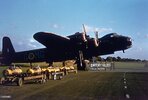At the beginning of ww2 all British bombs were painted Yellow Mustard overall
This cna be seen on this photograph:

With teh beginning of war operations, it appeared that the piles of bombs standing were too conspicuous and the practice spread of overspraying the upper part of these bombs stacks in green. We have photgraphs of this practice showing the upper side of teh bombs with green paint, the lower side remaining yellow, with the "border' between the paint beng sowhow wavy - Upper and lower refer to bombs lying on the ground, meaning that one side of the bomb was overpainted green while the other remained yellow.
On this photograph this situation is illustrated, the bombs have been uploaded on service trailers, the green side which was teh upper one on the bomb stacks is now the lower one on the trailers:

In late 1940 a new regulation stated that all bombs must be painted green instead of yellow.
In practice the regulation was applied very progressively, as the stocks were not systematically overpainted while the new bombs components were produced being painted green. Therefore there are, well after this date, photographs of bombs with the body painted yellow and the tail geen. this photographs from mid 1943 shows such a situation:

By end 1943 all bombs were integrally green overall.
US Bombs furnished to the British underwent a parallel process, and similar regulations were adopted by the the USAF (yellow to olive-green) and USN (grey to olive-green) with a parallel process of progressive integration of newly painted elements:


All this seems simple and logical and is confiormed by the majority of B&W photographs (see the IWM collection for isntance) BUT these are these 2 B&W photographs that raise some questions on the calendar I described:
1) This one is a Luftwaffe one supposed of have been taken in 1940 showing captured bombs:

The body of the center bomnb seems to have been painted in a definitively darker colour tahn the regular yellow-mustard of its tail and of teh otehr bombs. The presence of a lighter eau-de-nil band around teh nose confirms that the the body is indeed painted in a darker colour.
2) This other photograph comes from the Imperial war Museum and is also supposed to be from 1940 showimg a bombs being loaded into Battle bomber cell - here teh body is definitivekly in a lighter shade than the tail - but it may well be a weathering effect (or a training bomb body?) :









